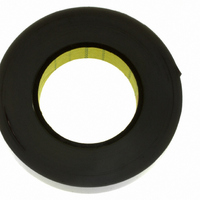9890 1 IN X 36 YD 3M, 9890 1 IN X 36 YD Datasheet - Page 3

9890 1 IN X 36 YD
Manufacturer Part Number
9890 1 IN X 36 YD
Description
THERM COND ADH 10MIL 1"X36YD
Manufacturer
3M
Type
Acrylic Adhesiver
Specifications of 9890 1 IN X 36 YD
Size / Dimension
1.00" W x 36 yd Roll
Lead Free Status / RoHS Status
Lead free / RoHS Compliant
Other names
3M9592
70006178894
70006178894
Application Guidelines
1.) Substrate surfaces should be clean and dry prior to tape application. Isopropyl alcohol (isopropanol) applied with a lint-
2.) Apply the tape to one substrate at a modest angle with the use of a squeegee, rubber roller or finger pressure to help
3) Assemble the part by applying compression to the substrates to ensure a good wetting of the substrate surfaces with the
4.) Application pressure guideline table for 3M™ Thermally Conductive Adhesive Transfer Tapes 9882, 9885, and 9890.
3M
9882 • 9885 • 9890
5.) Application Tips:
free wipe or swab should be adequate for removing surface contamination such as dust or finger prints. Do not use
“denatured alcohol” or glass cleaners, which often contain oily components. Allow the surface to dry for several
minutes before applying the tape. More aggressive solvents (such as acetone, methyl ethyl ketone [MEK] or toluene)
may be required to remove heavier contamination (grease, machine oils, solder flux, etc.) but should be followed by a
final isopropanol wipe as described above.
Note: Be sure to read and follow the manufacturers’ precautions and directions when using primers and solvents.
reduce the potential for air entrapment under the tape during its application. The liner can be removed after positioning
the tape onto the first substrate.
tape. Proper application of pressure (amount of pressure, time applied, temperature applied) will depend upon design of
the parts. Rigid substrates are more difficult to bond without air entrapment as most rigid parts are not flat. Use of a
thicker tape may result in increased wetting of rigid substrates. Flexible substrates can be bonded to rigid or flexible
parts with much less concern about air entrapment because one of the flexible substrate can conform to the other
substrates.
• For rigid to rigid bonding, a twisting motion during assembly of the substrates will improve wetting. This should be a
• For flexible to rigid or flexible to flexible bonding, a roll lamination system may be employed to apply the flexible
• Heat can be employed to increase wetting percentage and wetting rate of the substrates and to build room temperature
• Primers may be employed to increase adhesion to low surface energy substrates (eg. plastic packages). Contact your
• For best product performance, it is important to use pressure and time conditions to achieve as much wetting as possible.
™
3M representative for more information about primers.
back and forth twisting motion during the application of compression.
substrate down to the rigid (or other flexible) substrate. Rubber nip rollers, heated steel rollers, and other methods can be
employed to bond in a continuous manner.
bond strength.
Thermally Conductive Adhesive Transfer Tapes
Substrate
Rigid to rigid
Flexible to rigid
Flexible to flexible
Application Conditions
Minimum: 15 psi at room temperature
Preferred: 50 psi at room temperature
More pressure equals better wetting
Minimum: 5 psi at room temperature
Preferred: 15 psi at room temperature
Minimum: 5 psi at room temperature
Preferred: 15 psi at room temperature
(3)
2 sec
5 sec
1 sec
5 sec
1 sec
5 sec
Time












